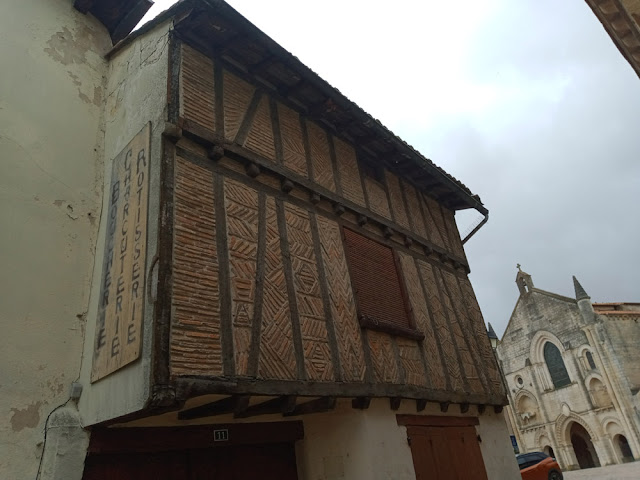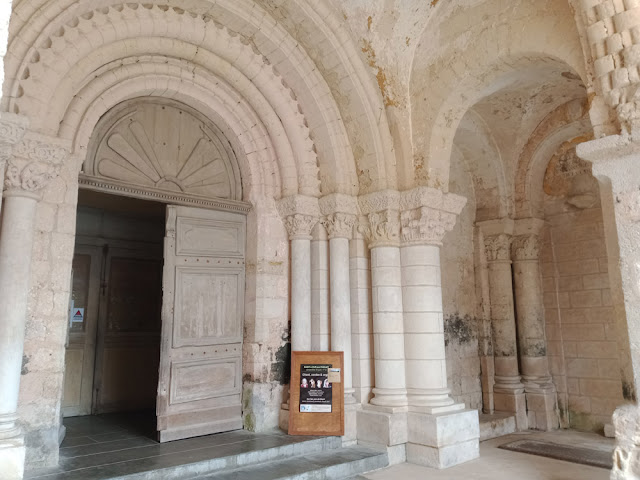On our way back from Morbihan in June we stopped off for a toilet break in Airvault in Deux-Sevres. I took ten minutes to check out the interior of the church. One of the things which struck me was a painting of the Madonna, with a plaque underneath in French and Polish. It said the painting was a gift from Polish soldiers on 4 April 1940.
What, I wondered, were Polish soldiers doing in a small town in the middle of nowhere in western France in April 1940, and why had they wished to make this gift? A bit of digging on the internet revealed a little known story that was part of a much bigger picture...
The Polish Madonna in the church at Airvault.
In September 1939 Poland was invaded by Nazi Germany and the USSR. On 3 September France declared war on Germany. In December 1939, France welcomed thousands of Polish soldiers, fleeing the occupation of their country. By June 1940 there were over 80 000 Polish soldiers in France. The men wore French military uniforms (with a Polish eagle on their berets), officers wore Polish uniforms. This was an Allied Army, attached to the French Command, but fighting under its own flag. More than half of these men were volunteers who were Polish immigrants already living in France when the War broke out, the rest were recruited from Poland.
Opened in 1939 on land requisitioned from private owners, the camp at Veluché straddled three municipalities territories (Airvault, Jumeaux and Saint-Loup), and closed in March 1941. In this period of under two years it had two distinct functions. From September 1939 to June 1940 it was primarily a training camp for the Polish Army (and a staging post for some Polish refugees who came via Hungary and Romania). The Polish government, led by General Sikorski in exile in Angers, decided to open two training camps for its refugee soldiers - one at Coëtquidan and another at Veluché. The proximity to a north-south train line with a double track, and a cement factory were the major deciding factors in choosing the location, as well as the fact that it was out of the way, in the middle of nowhere, hidden by trees, and very far from the Front Line.
The imposing market hall in the centre of Airvault.
The camp was constructed by a thousand Spanish Republicans, who were themselves refugees, supervised by French engineers. It was originally composed of five sections in an unenclosed triangle stretching over four kilometres and was primarily for training. There was also an arms depot, administration facilities, a medical service, water tower, observation posts and blockhouses, and a bakery, with roads, some sort of sewage treatment facility and electricity.
Although there were 500 barracks constructed of concrete, brick, timber and stone, with slate or fibro-cement roofs, to house newcomers, the soldiers were billeted with local residents, or allocated to empty barns, houses and attics, once they had received their basic training, mainly in Airvault, but also in Thouars, la Gatine and le Bocage. The local mayors had some difficulty finding accommodation for all these men, and the winter of 1939 was an unusually hard one. Officers were of course billeted in the homes of local residents in more comfort, and were given French lessons by volunteers. Hosts were paid 90 francs a month to provide a room and the officers were given 20 francs a day to cover their meals at local restaurants and cafés.
Medieval timber framed building in Airvault.
The more solid buildings were for housing the men, the timber buildings stabled horses used for transport and anti-tank batteries. There was an exercise field and a vast shooting range, and the soldiers were given long heavy World War I era rifles. Originally intended for 16 000 troops, in the end about 35 000 Poles, most of them aged between 16 and 18 years old, passed through the camp in ten months, creating unbreakable links with the local population. The camp's activities stretched over neighbouring fields, and arrangements were made with local farmers to establish when they could work their land. The road would be blocked while shooting practice was going on.
What stands out from the personal testimonies of locals who remember this time is the impression of the sheer numbers of men and how they were everywhere. Residents heard them singing and marching all the time, and shopkeepers reported that 75% of their takings were from these soldiers. There was an appreciation that these men were here to defend the French, and the future. Informal contact with the locals was warm, friendly, polite and respectful. So long as their French hosts spoke slowly and clearly the Poles understood most of what was being said to them. They knew the tune of the Marseillaise, although they were a bit vague on the lyrics. At Airvault they arrived on the train the week before Christmas, and suddenly they were everywhere. They clogged up the streets so that you couldn't circulate. They were very pious, drank the place dry and bought a lot from the shops in town. They sang beautifully and greatly enhanced the Mass, and especially Christmas. All these things made a strong impression on the locals.
The very large church on the market square in Airvault.
Charitable Franco-Polish organisations held events to ensure good friendly links between the two communities. There were concerts, theatre evenings, religious ceremonies, wreath laying ceremonies, military presentations, and a celebration of the Polish national day. In a six month period from December 1939 to May 1940 there were 22 public events of this nature in the area. One of the local newspapers had a daily column dedicated to the activities of the Polish soldiers. The soldiers also got quite a bit of attention from the young women of the area. The interest and kindness was reciprocated, and churches in both Airvault and Bressuire received gifts of copies of the painting of the Black Madonna of Czestochowa in 1940, and a cross was erected on the roadside near the station at Airvault.
But in June 1940 it was the Germans who were everywhere. One group of Polish soldiers left for the Front at Belfort. Others managed to get to England by embarking from la Rochelle, and participated in the Normandy landings four years later. On 21 June 1940 the camp was completely empty. The last eight Polish soldiers and a civilian were machine gunned down at the railway station. The same day the Germans entered Airvault. Shortly afterwards they discovered the existance of the camp.
Airvault, which I noticed was home to a good population of Swifts.
From October 1940 to March 1941 it became a prison camp for 'colonial' soldiers. Veluché was rather convenient for the Nazis. As they advanced at breakneck speed, they found themselves with tens of thousands of French soldiers to imprison. Amongst these there were a lot of men of colour, from the colonies (Antilles, Senegal, Morocco and elsewhere in Africa, Indochina). They made up nearly half the French Army. Propaganda from the 1920s meant that there still was a good deal of fear of 'blacks' amongst the Germans, and they didn't want these men detained in Germany.
The Nazis had already decided to create a prison camp for 'colonials' in the west of France. Veluché was perfect, and it became Fronstalag 231. The first prisonners arrived in October 1940. In total, in six months, around 12 000 soldiers of 28 nationalities were detained here. According to the official lists, only three Spanish and four French men were held here, including Jacques Ménard, who later became a Senator and Mayor of Thouars. Why he was held here is a mystery though.
Airvault.
Although the hundred or so other Fronstalags in France were managed by the French, Veluché was managed by the Wehrmacht directly, using mainly Austrian veterans, with twenty doctors (12 Germans and 8 French). Visits from local 'godmothers' were encouraged by the priest in Airvault.
In the beginning it wasn't the worst camp in which to live, but in January 1941 there was a turning point. There had been more than a hundred escapes, so the Germans put their minds to tightening security, mainly by employing younger guards.
Church porch, Airvault.
But the following month, another turn. An epidemic of tuberculosis began, to add its ravages to the already rampant dysentry. Eyewitness accounts tell of thick black smoke, leading historians to suppose that the bodies were burnt. Soon after, in March 1941, the camp was closed for good. Today, few vestiges remain of the camp itself, as it was demolished by the Germans.
After the War the bodies of 26 African troops were recovered from a mass grave near the water tower in the camp. They were reinterred in a dedicated military memorial cemetery at Airvault. There seems also to have been an incident in June 1940 when the railway station at nearby Thouars was bombed and some Polish soldiers were killed, and subsequently buried in a ditch at Airvault.
Sources: local history professor and Poitiers University lecturer, Mattieu Manceau, whose book on the subject, Un camp en Deux-Sèvres, Veluché 1939-1941, came out last year, and Gazet@ Beskid, a French language Polish online magazine.








1 comment:
so interesting...I hadn't heard this about all the Polish soldiers
Post a Comment